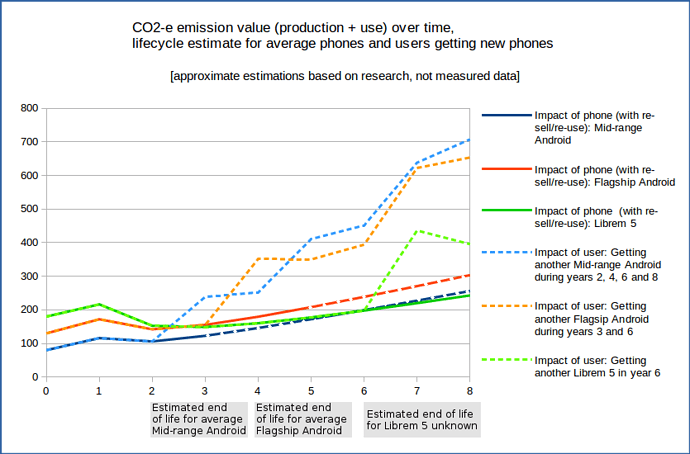@amosbatto Your data is impressive, very thorough and well thought out of. Good work! I take it you are in the field?
I’m not concerned about the charge emissions calculations, as that goes for all, not just L5. The faster pace of changing phones is the real culprit and makes long lasting phones the heroes. I’m not sure how to account in a simple way the amount of differing reused/-sold phones, but anyway, the faster pace of new phones just moves the dotted android lines left [edit: and L5 even more to right, in theory].
The charging / use of power and use of network are something that could be measured, so data on that could at least be updated. Too bad we may never get good comparison data on production (to which I’d also like to add equivalents from organization: marketing, buildings and other organizational activities etc.). And such a complex whole may never be totally mapped, as you pointed towards, but I’ll take your approximations. L5 has some disadvantages to bigger players, but over time it still seems better (especially when including lifecycle and next phones).
Regarding your three points, I’d suggest adding to the hardware centric list also OS and software. They are a major component of keeping a personal information device operatinal and current. Secondly, I think over time it may be even possible to increase efficiency and extend battery life as well as minimize network usage (although, I also imagine networks will be used more heavily on apps). Also, an environmental conscious user should prefer using apps and data that reside in their device - which mostly aligns with security/privacy conscious approaches. One example is how screens go dark and save power. Nokia - once upon time - squeezed extra power saving from their lock screen clock display by changing the font: a hollow font lights up less white pixels (edit: could now only find clock) - even design choises add over time (although is minor compared what else can be done).
Although there might be difference between 28nm and 5-7nm, I’d also consider reliability of “cruder” (which sound funny to me as I’m talking about nm scale  ) tech as an asset, considering reliability as well as probable longer lifespan.
) tech as an asset, considering reliability as well as probable longer lifespan.
For future… Should battery usege - and all usege for that matter - be differentiated to 3 to 5 profiles for better accuracy? One average does give enough of a picture, but if there is changing in use profiles over time, it would be interesting to keep an eye on. And people could see what difference changing habits makes. Although, at the same time, I recognize that might be a bit burdensome and there probably aren’t similar comparisons.
Thanks in advance for the spreadsheet. No hurry though, as shipments are a few months away, probably. I would like to see Purism make some sustainability report at some point (and perhaps recognize your contribution).
